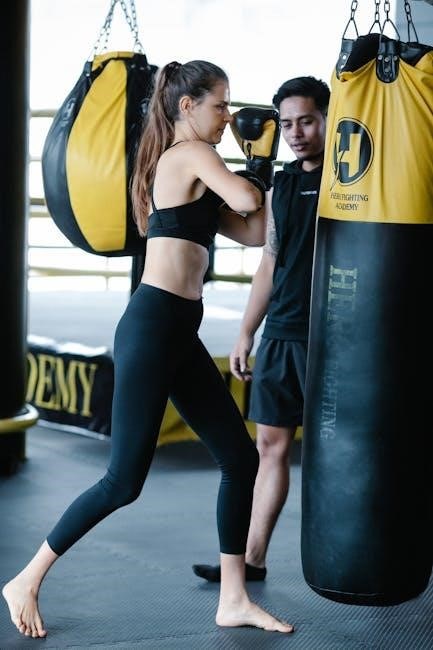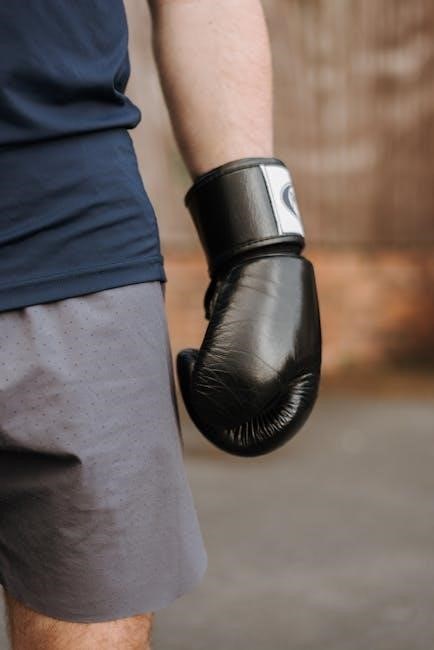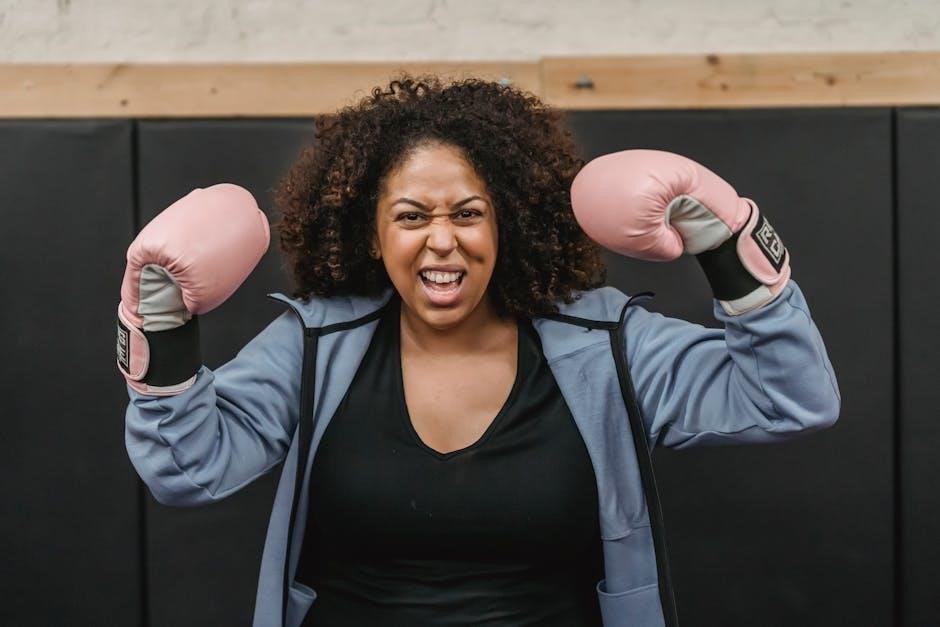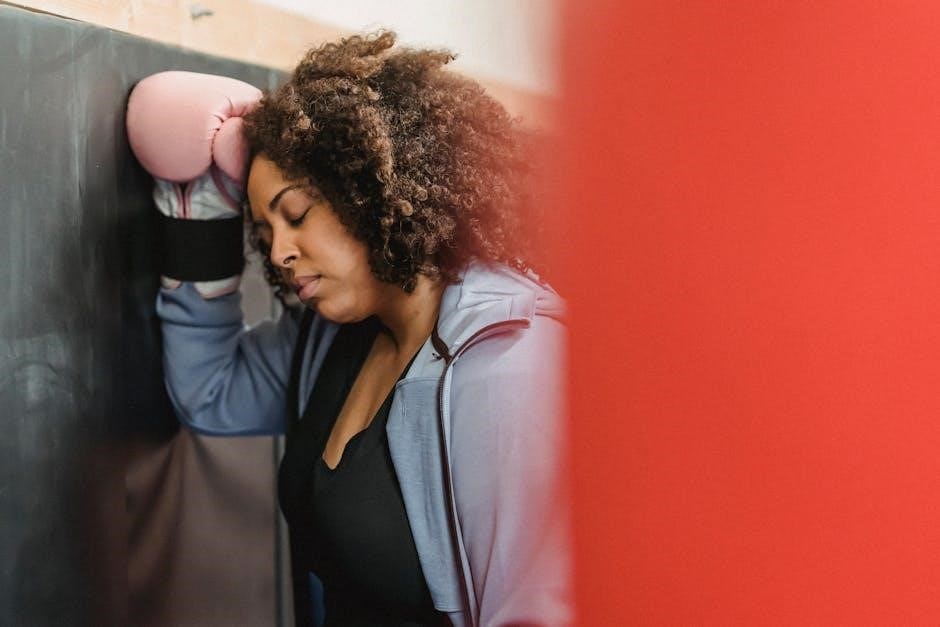Boxing glove sizes vary to suit different needs, from training to professional fights. Proper fit ensures performance, protection, and comfort. This guide helps you choose the right size.
1.1 Understanding the Importance of Proper Glove Size
Proper boxing glove size is crucial for both performance and protection. Ill-fitting gloves can lead to discomfort, reduced dexterity, and increased risk of injury. Correct sizing ensures adequate padding to absorb impact, protecting your hands and your opponent. It also enhances grip and control, allowing for precise punches and better technique. Selecting the right size prevents long-term damage to wrists, knuckles, and fingers. Whether for training or competition, proper gloves improve overall performance and safety. A well-fitted pair boosts confidence, enabling boxers to train more effectively and securely. Always prioritize proper fit to maximize protection and optimize your boxing experience.

Key Factors in Determining Boxing Glove Size
Hand circumference and user weight are key factors in selecting glove size, ensuring proper fit, protection, and performance for training or competition.

2.1 Weight Categories and Their Significance
Weight categories play a crucial role in determining boxing glove sizes. Gloves range from 8 oz for professional fights to 16 oz for sparring. Lighter gloves, such as 8-10 oz, are used in competitions to minimize padding and allow for faster punches. Heavier gloves, like 12-16 oz, are ideal for training and sparring, offering more cushioning and protection for both the wearer and opponent. The weight ensures safety and appropriateness for different boxing activities, balancing performance and protection based on the intensity and purpose of the session.
2.2 Measuring Hand Circumference for the Best Fit
Measuring hand circumference is essential for selecting the right boxing gloves. Wrap a flexible tape measure around your dominant hand, just below the knuckles, to determine your size. This ensures the gloves fit snugly without restricting movement. Proper fit prevents discomfort and improves performance. Hand size, combined with weight categories, helps match gloves to your needs. For example, larger hands may require heavier gloves for adequate padding. Accurate measurement ensures optimal protection and comfort during training or competition. Always consider both hand size and weight categories when choosing gloves for the best fit and functionality.

Boxing Glove Size Chart and Weight Options
Glove sizes range from 8 to 16 oz. Lighter gloves are for fights, heavier for training. Size charts guide weight and fit for optimal performance.
3.1 8-10 oz Gloves for Professional Fights

8-10 oz gloves are designed for professional boxing matches, offering minimal padding for a competitive edge. They are lightweight, allowing faster hand speed and precise punches. These gloves are regulated by governing bodies to ensure fair play and safety. Fighters typically choose 8 oz for lighter weight classes and 10 oz for heavier categories. Proper fit is crucial to avoid hand injuries. Many professionals prefer these sizes for their balance of protection and mobility during high-stakes bouts.
3.2 12 oz Gloves for Training and Mitt Work
12 oz gloves are ideal for training and mitt work, offering a balance of protection and mobility. They provide ample padding to absorb impact during intense sessions, making them suitable for heavy bag work and drills. These gloves are popular among boxers of all levels, as they support hand health while building endurance and strength. The additional weight compared to lighter gloves helps improve technique and power during mitt work with a coach. Their durability and cushioning make them a versatile choice for various training activities, ensuring both performance and safety in the gym.
3.3 14 oz Gloves for Bag Work
14 oz gloves are designed specifically for heavy bag work, providing superior cushioning and support. The extra weight and padding in these gloves absorb impact effectively, reducing strain on the hands during prolonged sessions. They are ideal for boxers who focus on bag training to build power and endurance. The enhanced protection minimizes the risk of injury, allowing for more intense and longer workouts. These gloves are a favorite among athletes who prioritize hand safety while honing their striking techniques. Their durability ensures they withstand rigorous training, making them a practical choice for serious bag work enthusiasts.

3.4 16 oz Gloves for Sparring
16 oz gloves are the standard choice for sparring, offering maximum protection for both the wearer and their partner. The additional weight and padding ensure reduced impact during exchanges, minimizing the risk of injury. These gloves are essential for high-intensity training sessions, providing a balance of safety and mobility. They are particularly recommended for heavier weight classes and those who prioritize hand and wrist protection. The cushioning in 16 oz gloves absorbs shock effectively, making them ideal for prolonged sparring rounds. Their durability also makes them a popular choice for regular training. For anyone engaging in sparring, 16 oz gloves are a must-have for safe and effective practice.
Choosing the Right Glove Size for Your Needs
Selecting the right boxing glove size depends on your weight, hand size, and training purpose. Proper fit ensures comfort, protection, and optimal performance during workouts or competitions.
4.1 Gloves for Training vs. Competition
Training gloves and competition gloves differ in weight and padding. Training gloves, typically 12-16 oz, prioritize hand protection and shock absorption during intense workouts and sparring. Competition gloves, usually 8-10 oz, are lighter, allowing for faster punches and less hindrance during matches. The choice between them hinges on the activity’s demands. For bag work or mitt drills, heavier gloves provide durability and cushioning, while lighter ones are ideal for speed and precision in fights. Understanding these distinctions helps boxers select the appropriate gloves for their specific needs, ensuring both performance and safety.
4.2 Considering Your Weight and Hand Size

Your weight and hand size are crucial factors in selecting the right boxing gloves. Measure your hand circumference below the knuckles to determine the best fit. Generally, heavier boxers or those with larger hands require bigger gloves for proper protection. For example, a 120kg boxer with a hand circumference of 22.25cm may opt for 14-16 oz gloves. Lighter boxers or those with smaller hands can choose smaller sizes. Balancing weight and hand size ensures optimal protection and mobility. Always consider these measurements alongside your training or competition needs to make an informed decision. Proper sizing enhances performance and safety, making it essential to prioritize both factors when choosing gloves.

Final Tips for Selecting Boxing Gloves
Ensure proper fit by measuring hand circumference and considering weight. Avoid oversized gloves for better control. Prioritize padding for protection, especially during sparring or heavy bag work.
5.1 Importance of Proper Fit and Protection
A proper fit ensures optimal protection and performance. Gloves that are too tight can restrict movement, while oversized gloves may reduce control. Adequate padding is crucial for absorbing impact, especially during sparring or bag work. Properly fitted gloves also support wrist alignment, reducing injury risks. Choosing the right size based on hand circumference and weight ensures comfort and effectiveness. Prioritizing fit and protection enhances training efficiency and safety, making it essential for boxers of all levels. Always select gloves that balance cushioning with dexterity for the best results in both training and competition.
5.2 Avoiding Common Mistakes in Glove Selection
Common mistakes in glove selection include choosing sizes based solely on weight rather than hand circumference. Overlooking the purpose of gloves, such as training versus competition, can lead to inadequate protection or performance. Ignoring padding quality and material durability is another oversight. Many boxers also neglect to consider their personal weight and hand size when selecting gloves. Additionally, some may prioritize style over functionality. To avoid these errors, measure hand circumference and match it with appropriate weight categories. Prioritize padding and material quality for durability. Tailor glove choice to specific activities, whether training, sparring, or professional fights. This ensures optimal protection and performance, preventing potential injuries and enhancing training effectiveness.
